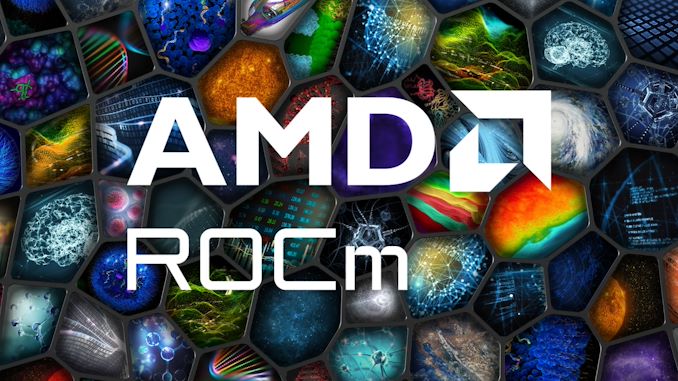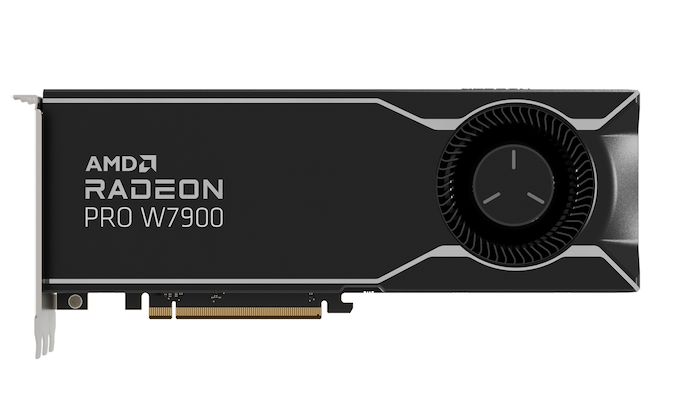AMD: Partial RDNA 3 Video Card Support Coming to Future ROCm Releases
by Ryan Smith on June 29, 2023 1:00 PM EST- Posted in
- GPUs
- AMD
- Machine Learning
- ROCm
- RDNA3

AMD this morning is formally announcing the launch of the latest version of its GPU compute software stack, ROCm 5.7. Along with making several important updates to the software stack itself – particularly around improving support for large language models (LLMs) and other machine learning toolkits – the company has also published a blog post outlining the future hardware development plans for the stack. In short, the company will be bringing official support to a limited set of RDNA 3 architecture video cards starting this fall.
AMD’s counterpart to NVIDIA’s CUDA and Intel’s OneAPI software stacks, AMD has historically pursued a narrower hardware focus with their own GPU compute software stack. ROCm exists first and foremost to support AMD’s Instinct line of accelerators (used in projects such as the Frontier supercomputer), and as a result, support for non-Instinct products has been limited. Officially, AMD only supports the software stack on a pair of workstation-class RNDA 2 architecture cards (Radeon Pro W6800 & V620), while unofficial support is available for some other RDNA 2 cards and architectures – though in practice this has proven to be a mixed bag as to how reliably it works. Consequently, any announcement of new Radeon video card support for ROCm is notable, especially when it involves a consumer Radeon card.
Closing out their ROCm 5.6 announcement blog post, AMD is announcing that support for the first RDNA 3 products will be arriving in the fall. Kicking things off, the company will be adding official support for the Radeon Pro W7900 – AMD’s top workstation card – and, for the first time, the consumer-grade Radeon RX 7900 XTX. Both of these parts are based on the same RDNA 3 GPU (Navi 31), so architecturally they are identical, and it’s a welcome sign to see AMD finally embracing that and bringing a consumer Radeon card into the fold.
Broadly speaking, RDNA 3’s compute core differs significantly from RDNA 2 (and CDNA 2) thanks to the introduction of dual issue SIMD execution, and the resulting need to extract ILP from an instruction stream. So the addition of proper RDNA 3 support to the ROCm stack is not a small undertaking for AMD’s software team, especially when they are also working to support the launch of the MI300 (CDNA 3) accelerator family later this year.
Along with the first two Navi 31 cards, AMD is also committing to bringing support for “additional cards and expanded capabilities to be released over time.” To date, AMD’s official video card support has never extended beyond a single GPU within a given generation (e.g. Navi 21), so it will be interesting to see whether this means AMD is finally expanding their breadth to include more Navi 3x GPUs, or if this just means officially supporting more Navi 31 cards (e.g. W7800). AMD’s statement also seems to imply that support for the full ROCm feature set may not be available in the first iteration of RDNA 3 support, but I may be reading too much into that.
Meanwhile, though it’s not by any means official, AMD’s blog post also notes that the company is improving on their unofficial support for Radeon product, as well. Numerous issues with ROCm on unsupported GPUs have been fixed in the ROCm 5.6 release, which should make the software stack more usable on a day-to-day basis on a wider range of hardware.
Overall, this is a welcome development to see that AMD is finally lining up support for their latest desktop GPU architecture within their compute stack, as Navi 3x’s potential as a compute product has remained less than fully tapped since it launched over half a year ago. AMD has taken some not-undeserved flak over the years for ROCm’s limited support for their bread-and-butter GPU products, so this announcement, along with CEO Dr. Lisa Su’s comments earlier this month that AMD is working to improve their ROCm support, indicate that AMD is finally making some much needed (and greatly awaited) progress with improving the ROCm product stack.
Though as AMD prepares to add further hardware support for ROCm, they are also preparing to take some away, as well. Support for products based on AMD’s Vega 20 GPU, such as the Instinct MI50 and Radeon Pro VII, is set to begin sunsetting later this year. ROCm support for those products will be entering maintenance mode in Q3, with the release of ROCm 5.7, at which time no further features or performance optimizations will be added for that branch of hardware. Bug fixes and security updates will still be released for roughly another year. Ultimately, AMD is giving a formal heads up that they’re looking to drop support for that hardware entirely after Q2 of 2024.
Finally, for anyone who was hoping to see full Windows support for ROCm, despite some premature rumors, that has not happened with ROCm 5.6. Currently, AMD has a very limited degree of Windows support in the ROCm toolchain (ROCm is used for the AMD backin in both Linux and Windows editions of Blender) and ROCm development logs indicate that they’re continuing to work on the matter; but full Windows support remains elusive for the software stack. AMD has remained quite mum on the matter overall, with the company avoiding doing anything that would set any expectations for a ROCm-on-Windows release. That said, I do still expect to see proper Windows support at some point in the future, but there's nothing to indicate it's happening any time soon. Especially with MI300 on the horizon, AMD would seem to have bigger fish to fry.
Source: AMD












15 Comments
View All Comments
Ryan Smith - Thursday, June 29, 2023 - link
And while this isn't really appropriate for the article itself, I really like the new documentation website they've launched for ROCm: https://rocm.docs.amd.com/en/latest/While the bulk of this documentation has always existed, the new website makes it easier to find and easier to follow.
nandnandnand - Thursday, June 29, 2023 - link
Take your time, it's not like you're years behind Nvidia.beginner99 - Friday, June 30, 2023 - link
Yeah like why only the 7900 XTX and not the 7900 XT? Makes not a lot of sense. I doubt AMD actual gets the problem? people don't develop on instinct cards unless you are HPC pro. but that it a small niche.Ryan Smith - Friday, June 30, 2023 - link
The 7900 XTX and W7900 have the exact same CU configurations. So it cuts down on their support matrix, as any code generated for one card will execute identically on the other.lmcd - Friday, June 30, 2023 - link
At this point they'll be behind Intel within a year or two in the compute space. It's disturbing to watch the incompetence.State of Affairs - Friday, June 30, 2023 - link
Intel is plagued with execution problems. Until management addresses the problems, challenging AMD in data center compute is a pipe dream.For example, Intel this month halted all shipments of its highest volume Sapphire Rapids SKUs due to a bug. No date has been provided when the shipments will resume, which is quite the bad look for Intel given that Sapphire Rapids experienced multiple production delays and missed launch dates. Not surprisingly, Oracle announced this month that it is no longer buying Intel processors for its data center. Instead, Oracle will buy from AMD for its x86 needs. You can expect to see more of these kinds of announcements going forward.
lmcd - Tuesday, July 4, 2023 - link
I agree with your comments as they pertain to Intel's horrifying server-space CPU execution problems, but my comment is focused on discrete GPUs and their compute abilities. People are actually engaging with Intel's OneAPI (I think that's the branding? idk) in a meaningful way already, which is already a faster uptake than AMD has ever had.Yes, Intel's inroads could stagnate due to hardware execution on the GPU side, but given that Intel can afford to slap excessive amounts of VRAM on consumer-priced parts with full compute access, I think Intel actually will surpass AMD in data center compute on the GPU side.
Intel's x86 data center design was completely arrogant and had a low chance of success. It's a shame that Xeon Phi designs aren't around to let Intel juice some fake "market leading performance" numbers while their weird tiled design flounders. A Xeon Phi socketed CPU running OneAPI combined with their current ARC platform would have been a pretty fun platform, even if optimizing for it would be on par in difficulty with optimizing for the modern mainframe platforms.
andrewaggb - Tuesday, July 4, 2023 - link
well who uses ai anyways 🤦let's mark a card with 24GB of ram and nothing to do with it...
wolfesteinabhi - Friday, June 30, 2023 - link
they really need to step up the software game ... its not going to help jsut hardware if no one can use it efficiently enough.Also, big part of why CUDA was a success, coz its accessible(apart from having almost 0 competition ..OpenCL doesnt count :P ) on lower end hardware and Windows (which is where almost all studends and many devs start on)
deksman2 - Sunday, July 2, 2023 - link
Actually, AMD did in fact improve ROCm recently for their Instinct GPU's... and now they are getting up to 80% of performance of NV's equivalents such as A100.Granted, that's the Instinct line, and that's their main priority it seems, but I do agree they need to step up their game in the consumer space too, since most people would be in fact using consumer grade GPU's as they are cheaper than the PRO ones.